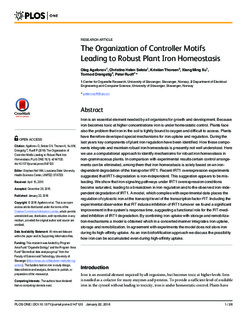| dc.contributor.author | Agafonov, Oleg | |
| dc.contributor.author | Selstø, Christina Helen | |
| dc.contributor.author | Thorsen, Kristian | |
| dc.contributor.author | Xiang, Ming Xu | |
| dc.contributor.author | Drengstig, Tormod | |
| dc.contributor.author | Ruoff, Peter | |
| dc.date.accessioned | 2016-09-19T07:55:02Z | |
| dc.date.available | 2016-09-19T07:55:02Z | |
| dc.date.issued | 2016-01 | |
| dc.identifier.citation | Agafonov et al. (2016) The organization of controller motifs leading to robust plant iron homeostasis. PLoS ONE 11(1): e0147120. doi:10.1371/journal.pone.0147120 | nb_NO |
| dc.identifier.uri | http://hdl.handle.net/11250/2408219 | |
| dc.description | This is an open access article, originally published in Plos ONE, distributed under the terms of the Creative Commons Attribution License, which permits unrestricted use, distribution, and reproduction in any medium, provided the original author and source are credited. | nb_NO |
| dc.description.abstract | Iron is an essential element needed by all organisms for growth and development. Because iron becomes toxic at higher concentrations iron is under homeostatic control. Plants face also the problem that iron in the soil is tightly bound to oxygen and difficult to access. Plants have therefore developed special mechanisms for iron uptake and regulation. During the last years key components of plant iron regulation have been identified. How these components integrate and maintain robust iron homeostasis is presently not well understood. Here we use a computational approach to identify mechanisms for robust iron homeostasis in non-graminaceous plants. In comparison with experimental results certain control arrangements can be eliminated, among them that iron homeostasis is solely based on an iron-dependent degradation of the transporter IRT1. Recent IRT1 overexpression experiments suggested that IRT1-degradation is iron-independent. This suggestion appears to be misleading. We show that iron signaling pathways under IRT1 overexpression conditions become saturated, leading to a breakdown in iron regulation and to the observed iron-independent degradation of IRT1. A model, which complies with experimental data places the regulation of cytosolic iron at the transcript level of the transcription factor FIT. Including the experimental observation that FIT induces inhibition of IRT1 turnover we found a significant improvement in the system’s response time, suggesting a functional role for the FIT-mediated inhibition of IRT1 degradation. By combining iron uptake with storage and remobilization mechanisms a model is obtained which in a concerted manner integrates iron uptake, storage and remobilization. In agreement with experiments the model does not store iron during its high-affinity uptake. As an iron biofortification approach we discuss the possibility how iron can be accumulated even during high-affinity uptake. | nb_NO |
| dc.language.iso | eng | nb_NO |
| dc.publisher | Public Library of Science (PLoS) | nb_NO |
| dc.rights | Navngivelse 3.0 Norge | * |
| dc.rights.uri | http://creativecommons.org/licenses/by/3.0/no/ | * |
| dc.subject | biologi | nb_NO |
| dc.subject | homeostasis | nb_NO |
| dc.subject | iron | nb_NO |
| dc.subject | plant vacuoles | nb_NO |
| dc.subject | homeostatic mechanisms | nb_NO |
| dc.subject | ferritin | nb_NO |
| dc.subject | iron deficiency | nb_NO |
| dc.subject | cytosol | nb_NO |
| dc.subject | transcription factors | nb_NO |
| dc.title | The organization of controller motifs leading to robust plant iron homeostasis | nb_NO |
| dc.type | Journal article | nb_NO |
| dc.type | Peer reviewed | nb_NO |
| dc.rights.holder | © 2016 Agafonov et al. | nb_NO |
| dc.subject.nsi | VDP::Mathematics and natural science: 400::Basic biosciences: 470 | nb_NO |
| dc.source.volume | 11 | nb_NO |
| dc.source.journal | Plos One | nb_NO |
| dc.source.issue | 1 | nb_NO |
| dc.identifier.doi | 10.1371/journal.pone.0147120 | |

